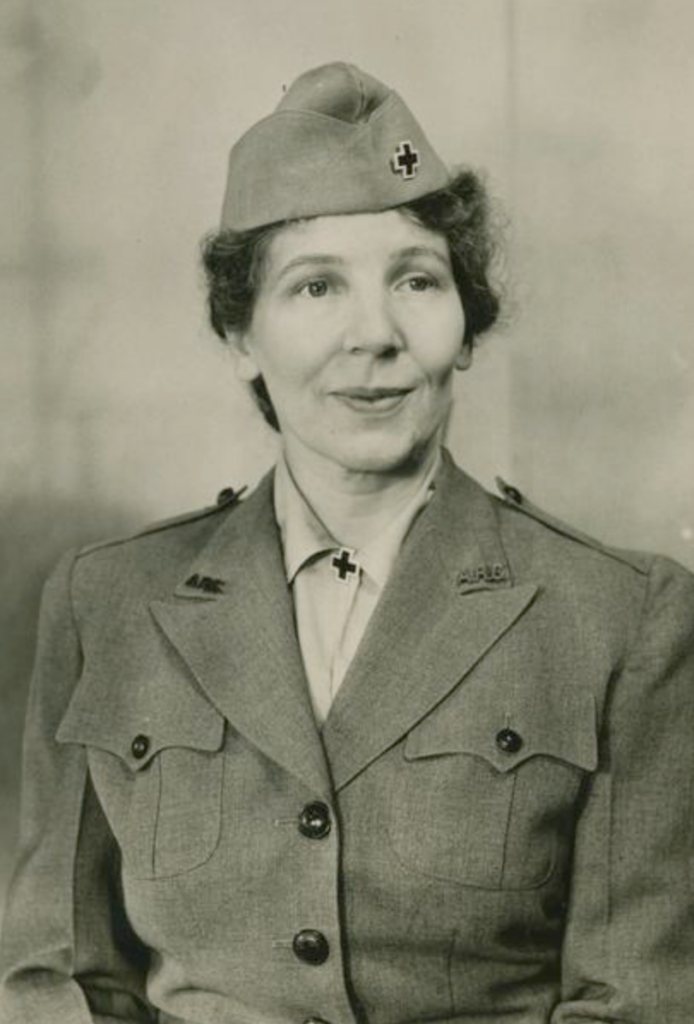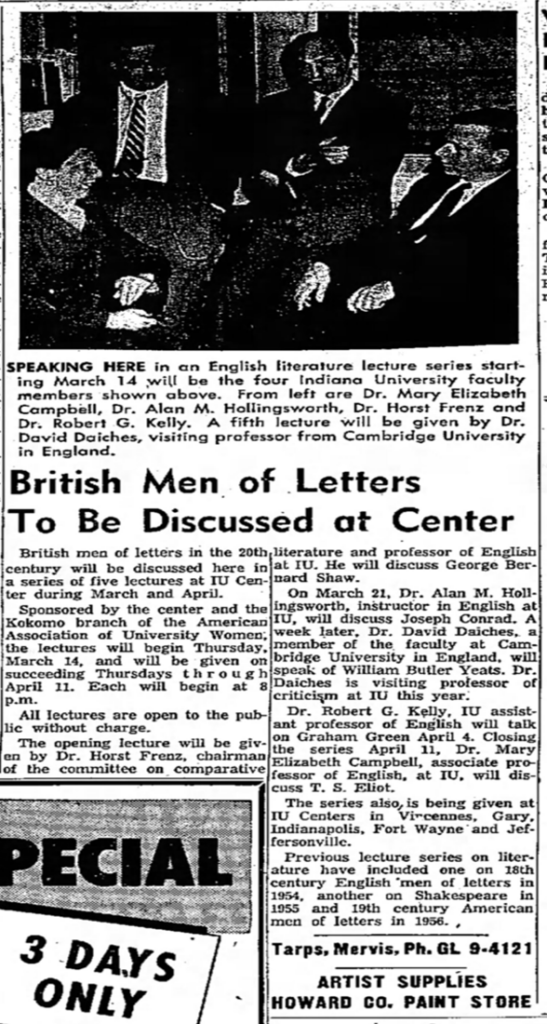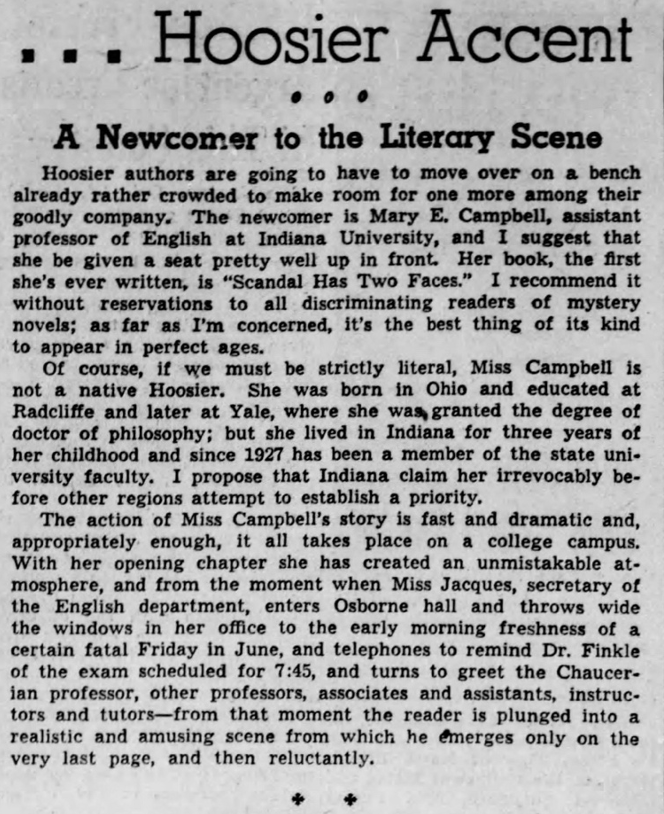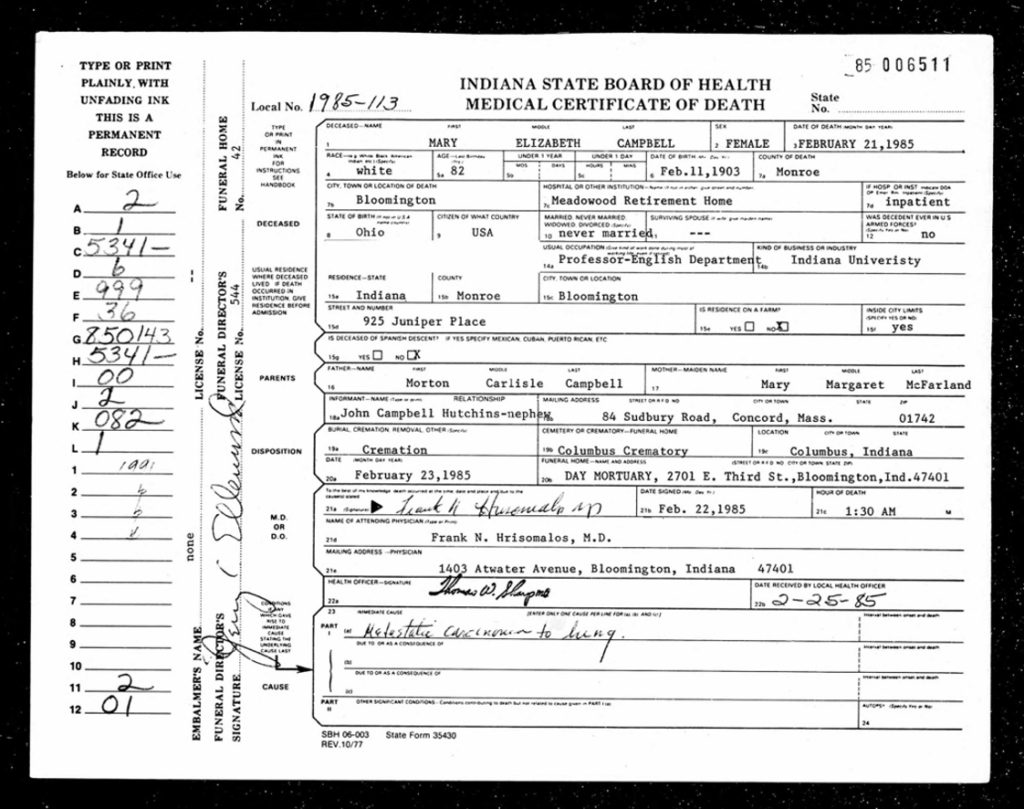Mary Elizabeth Campbell by Karolina Sroka

Devoted, driven, and dauntless. These adjectives describe Mary Elizabeth Campbell’s persona perfectly. She devoted much of her life to make an influential impact on Indiana University. Mary’s driven personality propelled her to publish several original works which includes a popular favorite: Scandal Has Two Faces. Finally, Mary’s dauntless acts throughout her life include serving in World War II, confronting problems that faced professional and educated women, and teaching the first comparative literature course offered at Indiana University.

Although Cambridge, Ohio was Mary’s birthplace, she had a connection with Bloomington early on in her life. When she was around thirteen years, Indiana University offered her father a position as a professor. As a result, her whole family moved to Bloomington. Just three years later, her father became a professor at Harvard. Nonetheless, IU remained a short-lived, yet inspiring experience and held a special place in Mary’s heart. In fact, after finishing school from Cambridge Latin School and Radcliffe, Mary became an English instructor at IU in 1927 and rose through the ranks, retiring as Professor Emeritus in 1973. Talk about devotion! Throughout her time as a faculty member, Mary took the time to advance her education at Yale, where she gained her PhD in the year 1938. As seen in the clipping from The Kokomo Tribune, Mary along with other notable IU faculty members discussed an English literature series called British Men of Letters. Not only did Mary devote her time as an English professor at IU Bloomington, but she also participated in spreading her knowledge to a broader audience.

Mary made the most use of her time as a professor at Indiana. She always had a passion for writing and took it upon herself to publish something. In the year 1938, the same year she gained her PhD, Mary published her first book named Defoe’s First Poem. This publication focuses on Daniel Defoe, a writer, journalist, pamphleteer, and even spy who was seen as an early and passionate proponent of the English novel. Defoe must have been an inspiration for Mary as they share a passion for English literature and novels, and ultimately helped drive Mary to publish her own works. Actually, in 1943, she published yet another book called Scandal Has Two Faces, which sparked more popularity. This murder mystery came out before academic novels were considered popular, so it intrigued critics and scholars. Set in academia, this novel excited all ages with its clever humor and plot. The fictious story takes place on a college campus, making it even more enticing for students. It allowed them to engage and feel a part of the story. Even in the Hoosier Accent, as seen in the clipping, Mary receives much praise on her novel. This hopefulness ande ncouragement the article displays further fuels Mary’s drive for writing. There was a lot of positive feedback on the novel, and for some time Mary seriously considered writing a sequel to the mystery, but ultimately could not because of unplanned yet critical events. This goes to show how great of an impact Mary made on English literature at Indiana, mainly because of her driven personality.
Shortly after the publication of her mystery novel Scandal Has Two Faces, Mary took a year’s leave for the unplanned, yet critical event mentioned earlier. It was to serve and help in World War II. Mary specifically went to serve in Italy. There, she worked with the Overseas Hospital Service of the American Red Cross. In all of the hospital service units located in Italy, the nurses and medical teams worked long hours and their time and effort was very much appreciated. One article stated that many units had “periods when the patient load was heavy” (Merrick 40). Mary’s dauntless acts as a nurse and the whole experience impacted her views and thoughts of women, but specifically the importance of their duties. Thus, after returning to the United States in 1945 and Indiana University for the spring semester, she started to engage in the Indiana University Bulletin called “What Makes an Educated Woman.” As an editor, Mary tackled and addressed problems facing professional woman. What makes this so inspiring and daunting, is the fact that these issues were not relevant yet. Amidst all these events, when Mary was at Indiana University, she taught comparative literature, which was actually the first comparative literature course ever taught at IU. Because “literature was alive and exciting” for her and “she was able to communicate its vitality to her classes,” Mary had an innovative style of teaching (IU Bloomington Faculty Council). All of these daunting acts contribute to the moving life-story of Mary Campbell.

Mary Elizabeth Campbell passed away on February 21, 1985 at the Meadowood Retirement Community in Bloomington, Indiana, as seen on her death certificate. Mary retired as an IU professor after almost fifty years of teaching in 1973. No surprise when she received emeritus status by the university at that time. She never married, but instead lived an unselfish, courageous, and admirable life. Not only did she inspire and impact her own students, but also faculty across IU and the audience who read her publications. This can be seen not only through her connection to IU from an early age, but also her role as a professor, a writer, and a nurse. Mary Campbell’s devoted, driven, and dauntless personality will continue to live on and influence others not only at Indiana University, but across the United States.
Bibliography
“Archives Photograph Collection of Mary E. Campbell.” Indiana University Bloomington, webapp1.dlib.indiana.edu/archivesphotos/results/item.do?itemId=P0067323.
“Daniel Defoe.” Poetry Foundation, Poetry Foundation, www.poetryfoundation.org/poets/daniel-defoe.
“Indiana Death Certificate for Mary Campbell.” Ancestry.com, www.ancestrylibrary.com/imageviewer/collections/60716/images/44494_351913-00535?treeid=&personid=&hintid=&queryId=88f0b9ea827548f57ffb54872139d3db&usePUB=true&_phsrc=kXW1&_phstart=successSource&usePUBJs=true&pId=2793800.
“The Indianapolis Star from Indianapolis, Indiana on October 27, 1943 · Page 12.” Newspapers.com, The Indianapolis Star, www.newspapers.com/newspage/104924129/.
IU Bloomington Faculty Council. “Memorial Resolution Professor Emeritus Mary Elizabeth Campbell.” Bloomington Faculty Council Minutes, 24 Sept. 1985, webapp1.dlib.indiana.edu/bfc/view?docId=B06-1986.
“The Kokomo Tribune 6 Mar 1957, Page 11.” Newspapers.com, The Kokomo Tribune, www.newspapers.com/image/2451840/?image=2451840.
Merrick, Ben A. “The 56th Evacuation Hospital (Baylor Unit) Overseas in World War II.”
Taylor & Francis, 28 Jan. 2018, www.tandfonline.com/doi/abs/10.1080/08998280.1992.11929794.
Leave a Reply